Everything you need to know about time management (+ tips)
Time management is a crucial component of a happy, productive, opportunity-filled life. Unfortunately, many people are just not good at it.

This comprehensive time management guide will:
- Help you understand the essentials of successfully managing your time,
- Provide you with myriads of time management tips and strategies, and
- Show you how to use time management apps such as Clockify to your advantage.
Contents
 CHAPTER 1
CHAPTER 1
- What is time management?
- Time management advantages
- The importance of time management
- How do average people manage time?
 CHAPTER 2
CHAPTER 2
- Signs of poor time management skills
- 10 best time management skills
 CHAPTER 3
CHAPTER 3
- 26 best time management strategies
 CHAPTER 4
CHAPTER 4
- 54 best time management tips
- Time management tips for students
- Time management environment tips
 CHAPTER 5
CHAPTER 5
- Best time management tools
Time Management Introduction

What is time management?
Time management is the process of planning, organizing, and controlling the time spent on specific activities. It is the ability to use the time you have in a day productively and effectively.
A vital subtype of time management is organizational time management. It involves organizing your time and activities in such a way that helps you identify time wastage, evaluate it, and reduce it.
Many people turn to various free time management apps to help them better organize their time.
Overall, time management is crucial for your success at work, but it's also crucial for helping you find time for your family, friends, hobbies, as well as personal commitments and interests.
The most important concept of time management are priorities.
Time management centers around:
- Setting priorities
- Maximizing the time you spend on priorities
- Reducing the time you spend on non-priorities
However, despite the term being "time management", strictly speaking, time itself cannot be managed because it is a fixed component.
You cannot prolong 2 hours in a day, but you can maximize the number of priority activities you finish during said 2 hours.
So, to practice successful time management, you'll need to possess and nurture the right set of skills.
Examples of time management skills include:
- Effective task delegation
- Setting and meeting goals
- Making efficient decisions
- Managing your appointments and errands, either alone, or in a team
- Managing your projects
- Making comprehensive daily, weekly, monthly, and yearly schedules
- Analyzing and solving problems
- Planning and coordinating events
- Efficient teamwork on the whole
The advantages of effective time management
Time management, when done right, has several prominent advantages.
Effective time management relieves stress
Proper time management involves following a schedule and checking off items on a to-do list.
This way, you feel like you have everything under control, so you feel much less stressed about your work.
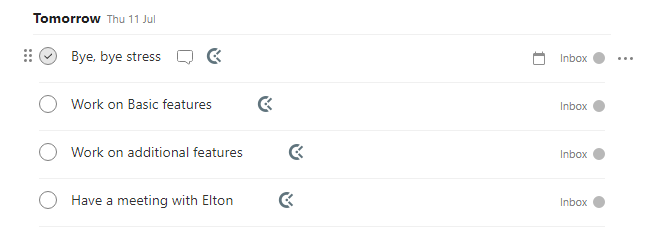
Effective time management gives you more time
Proper time management involves blocking time in your schedule for important activities, and timeboxing your errands so that you avoid spending too much time on them.
All this saves time and provides more opportunities to:
- Socialize with friends,
- Spend some quality time with your family,
- Practice a hobby, or
- Pursue other personal interests.
Effective time management helps you reach your goals
Proper time management involves sorting out priorities and other errands in a way that leaves you with enough time to consider, find, and pursue the right goals.

Effective time management makes you more confident
Proper time management involves finishing your work on time and leading an organized life.
People around you start to admire you because of these qualities, which helps boost your morale and confidence, resulting in a resolution to continue with such an organized lifestyle.
Effective time management helps you procrastinate less
Proper time management involves clear schedules that leave no or little room for being idle.
You'll feel encouraged to stick to your planned daily activities and procrastinate less as a result.
The importance of time management
As we've seen in the "The advantages of effective time management" section, proper time management helps you gain and maintain control over your life as a whole.
Without proper time management, you'll probably waste hours on trivial activities and neglect your priorities.
Then, you'll likely skip meals or reduce sleep time, all to save some of the lost time for work activities.
However, you'll still get little done because it's impossible to focus properly when you're hungry or tired.
So, time management is important because it helps you:
- Finish want you want
- Finish what you want faster
- Finish more in less time
- Waste less time
- Find time for leisure activities
- Find time for proper meals and enough sleep
Moreover, time management also helps you reduce stress as a result of having quality work finished before the deadline, with plenty of time for hobbies and friends.
In the end, you'll be more likely to enjoy success in life, but also learn from your losses, as well as understand what steps to undertake to minimize these losses in the future.
How do average people manage time? (Statistics)
According to time management facts and figures and time tracking statistics:
- People spend less than 2 minutes in significant conversation with their spouses and partners, and less than 30 seconds in significant conversation with their children — meanwhile, about 95% of all marriages break up because of a "lack of communication" which occurs due to “a lack of time to communicate”.
- An average person gets interrupted once every 8 minutes, losing at least 5 minutes on requests which have "little or no real value" — the total time wasted on such interruptions builds up to 3 hours by the end of the day.
- People who work at chaotic desks spend about 1.5h per day, or 7.5h per week looking for something.
- On average, working people sleep about 7 hours per day, and spend about 35 minutes on their commute to work.
- Regular employees spend about 6 hours per week on meetings — and 9 out of 10 people spend meetings daydreaming.
- Only 20% of the time at work is spent on meaningful tasks, while 80% is spent on tasks with "little or no value".
- As many as 40% of working people skip breakfast, and 39% skip lunch — about half of the people who do eat lunch, allocate only 15 minutes to their lunch breaks.
- As many as 78% of all Americans would like to have more time to relax and unwind — and, as many as 75% feel constantly tired.
- It usually takes twice as long to finish the task than what you originally estimated.
As evident, a lot of time during the day gets wasted, mismanaged, or miscalculated.
Here are the signs that you too are a part of the statistical sample who manages their time poorly.
Time Management Skills
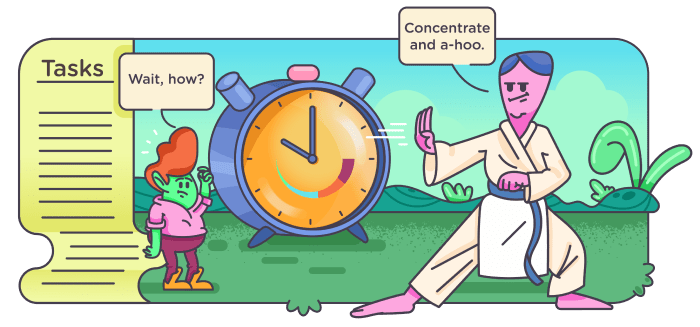
Signs you have poor time management skills
Several giveaway signs indicate you have poor time management skills.
You're always late
You're always late to meetings and constantly breaching deadlines on projects.
Reason? You take on many tasks, make many promises, and, in the end, you simply can't follow them through.
You're slow with your work
It takes you 2 hours to finish a task most other people would finish in under an hour.
Reason? Your work lacks the organization that would help you structure your work better and finish your assignments faster.
You waste a lot of time
You spend 3 hours on an easy task — 2 hours more than it's really necessary.
Reason? You don't have a strict schedule saying when you should start and when you should stop working on a task. You work on tasks in random order, and have no clear organizational system for work.
Parkinson’s law: why you waste time and how to avoid itYou often experience a lack of energy
You feel exhausted all the time — like you have no time to eat, sleep, or rest.
Reason? You're constantly procrastinating and falling behind with your assignments, so you spend extra hours after work trying to catch up.
You're often indecisive
You're constantly confused about your priorities, and you spend extra time unable to decide what to tackle next.
Reason? You lack a clear agenda that shows your daily priorities and how they relate to your goals.
You take on too much work
You're always taking on requests from others, until you have no time for your own assignments.
Reason? You don't understand what your priorities are, how to define them, and how to make sure you do them first.
The reason behind chronic poor time management
If the above-listed reasons for poor time management are sporadic, you can likely solve them yourself after some time and practice.
However, chronic problems with time management — including difficulties getting started with a task, organizing and following your schedule, as well as following through with your tasks — may indicate Attention Deficit Hyperactivity Disorder (ADHD) or Attention Deficit Disorder (ADD).
This disorder involves:
- Difficulties with paying attention
- Reduced emotional control
- Excessive activities
- Overall difficulty with controlling behavior
Most importantly, ADHD affects your ability to mark the passage of time and make plans accordingly, so proper time management becomes difficult.
For more information about ADHD disorder, consult the National Institute of Mental Health website.
❗DISCLAIMER: If you think you may be experiencing symptoms of ADHD, we encourage you to consult a healthcare professional and refrain from self-diagnosing.
10 best time management skills to have
To overcome poor time management skills and other difficulties in your work, you'll need to possess the right time management skills.
Here, we list 10 must-have skills you need to nurture if you want to make the most of your time.
The ability to define SMART goals
Establishing SMART goals means setting goals that are Specific, Measurable, Attainable, Relevant, and Time-bound. A goal tracking app can help you stay on track with your SMART objectives.
Time management problems SMART goals solve
- Wasting a lot of time
How SMART goals solve time management problems
- Specific goals — You're clear on what you want to achieve, where, when, why, how, and with whom, and you're clear on the limitations of your goal.
- Measurable goals — It's possible to understand whether and when you've reached the said goal.
- Attainable goals — It's possible to reach said goal.
- Relevant goals — You decide what you want to achieve in life, and set your goals accordingly.
- Time-bound — Your goal is fixed to a deadline you need to live up to.
The ability to plan and organize your day
Planning your priorities and organizing your day around them helps you save time and finish what you need.
Time management problems planning your day solves
- Being late all the time
How to organize your day to solve time management problems
- Identify your most important and most urgent tasks for that day.
- Delegate or eliminate everything else.
- Compile your priorities and make a to-do list.
- Note down your priorities in a calendar, and follow your schedule.
The ability to manage your stress
High stress levels hinder your ability to perform well at work, which is why it’s vital to keep your stress level at bay.
Time management problems stress management solves
- Experiencing a lack of energy
How to use stress management to solve time management problems
- Meditate or try out a similar relaxation method.
- Make sure you get enough sleep and don't skip meals — you'll be even more anxious if you're hungry or tired.
- Avoid nicotine and alcohol.
- Say "No" to extra work.
The ability to delegate tasks
If you delegate tasks you're not obliged to do, you'll save time for priority and urgent tasks.
Time management problems task delegation solves
- Experiencing a lack of energy
- Wasting a lot of time
How to use task delegation to solve time management problems
- If you're having trouble letting go of tasks, start small — delegate smaller tasks first, and work your way up from there.
- Delegate tasks that are urgent but less important.
- Define task expectations and include task instructions.
- Trust your colleagues to do the job right, but verify that they did in the end.
The ability to avoid distractions
Distractions, such as your phone, social media, and chatty colleagues, take away from the time you should spend working, so later you need to invest extra effort into trying to make up for it.
Time management problems avoiding distractions solves
- Being slow with your work
How to avoid distractions to solve time management problems
- Put your phone in the other room during work time.
- Define the maximum time you can spend on social media and stick to it.
- Wear headphones to block out outside noises and ask your colleagues not to interrupt you when you're focused on work.
The ability to single-task
Single-tasking is the new multitasking — you cannot properly focus on several tasks at a time, so it's best that you work on one task only during a fixed time period.
Time management problems single-tasking solves
- Wasting a lot of time
How to use single-tasking to solve time management problems
- Set a time block for your task.
- Get rid of all distractions, don't take on new requests, and try not to let anyone interrupt you.
- Set a timer for your task, and stick to the predetermined time.
- If it's a larger task, parse it into chunks, allocate some time for each, and take breaks in-between.
The ability to say ‘No’
If you take on every request sent your way, you'll only be working on other people's priorities, not your own.
Time management problems saying ‘No’ solves
- Taking on too much work
How to say ‘No’ to solve time management problems
- "Thanks, but I'll have to pass."
- "Let me think about it and I'll get back to you."
- "I don't have time right now, but I can recommend someone else."
- "I wish I had the time, but I'm currently preoccupied with some other work."
- "I appreciate you asking me, but I have other arrangements planned for that day."
The ability to put effort into high-value work
If you put 20% of your efforts into the right tasks, you'll match 80% of your expected results.
In other words, instead of working on 8 easy tasks that solve only 2 of your problems, work on 2 more difficult tasks that solve 8 of your problems.
Time management problems focusing on high-value work solves
- Being indecisive
- Wasting a lot of time
How to focus on high-value work
- Focusing on high-value work in content — Analyze the characteristics of the 20% of the blog posts that bring 80% of your traffic, and replicate them in future blog posts.
- Focusing on high-value work in software development — Identify the 20% of the features that attract 80% of the app's users, and focus on perfecting them.
- Focusing on high-value work in project management — Identify the 20% of the critical tasks that bring 80% of your failures, and allocate extra time to making them work.
The ability to avoid procrastination
Building an entire Winterfell castle complete with a teeny-tiny Jon Snow out of matches sure is fun! But, you shouldn't do that during work hours because you'll just lose time and double your work for tomorrow.
Time management problems avoiding procrastination solves
- Being slow with your work
How to avoid procrastination to solve time management problems
- Make deadlines, expectations, and goals clear — it's easier to keep going when you know where you're going.
- Parse complex and difficult tasks into smaller subtasks to make the overall task less daunting and more achievable.
- Define deadlines for the parsed task to make it seem more immediate.
- Plan your subtasks in more detail and allocate specific time to them.
- Visualize potential obstacles to stop fearing failure.
- Accept that your work shouldn't be perfect.
The ability to identify priority tasks
When you know what your most important and most urgent tasks are, you know what you need to do first.
Time management problems prioritizing tasks solves
- Taking on too much work
- Being indecisive
How to prioritize tasks to solve time management problems
- Do the most demanding, most difficult, most time-consuming task first thing when you get to work — this method is called "Eating the frog". It helps you finish your priorities, and clear the remaining schedule for that day for more pleasant activities.
- Implement the Eisenhower Matrix to decide what to do first and second, and what to delegate or eliminate.
Time Management Strategies

26 best time management strategies to implement
Here are the 26 best time management strategies you can try at work or for handling your personal errands.
Pomodoro — for better focus
Parse your work into 25-minute work sessions and 5-minute breaks.
After 4 such cycles, take a longer, 20-minute break.
Rinse and repeat until done for the day.
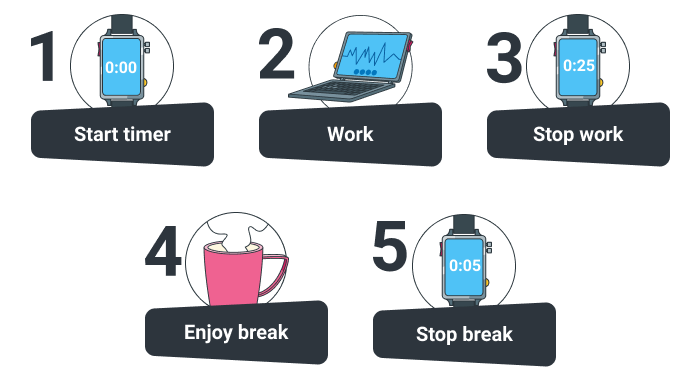
Key benefits of Pomodoro
- You'll work in fixed time intervals and be more likely to focus.
- You'll take frequent breaks and decrease the risk of burnout.
Kanban — for maximizing efficiency
Take a visual approach to task tracking:
- Add tasks,
- Define progress levels, and
- Move tasks across columns as their progress level changes.
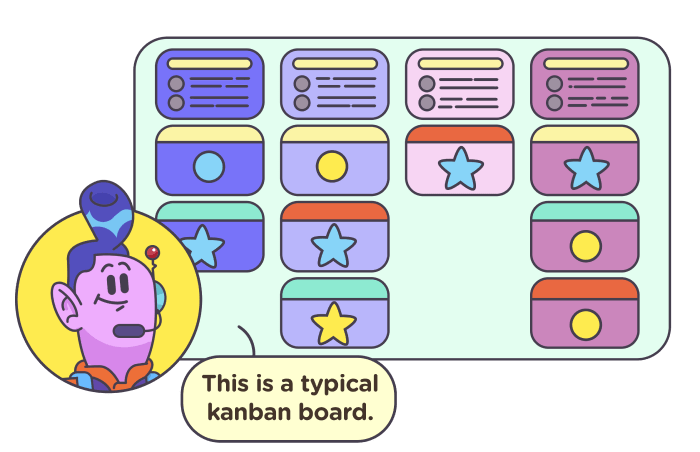
Key benefits of Kanban
- Kanban is a customizable approach that lets you break the projects into manageable tasks and subtasks.
- It helps you put all your energy into progressing with the project.
Getting Things Done — for decluttering your mind
Capture, clarify, organize, reflect and work on tasks in your to-do list.

Key benefits of Getting Things Done
- Getting Things Done is great for managing all your ideas and priorities.
- The method helps you tackle both personal and business tasks.
Eat That Frog — for effective prioritization
Prioritize tasks by difficulty, urgency, and importance, and tackle the most significant task first thing in the morning.
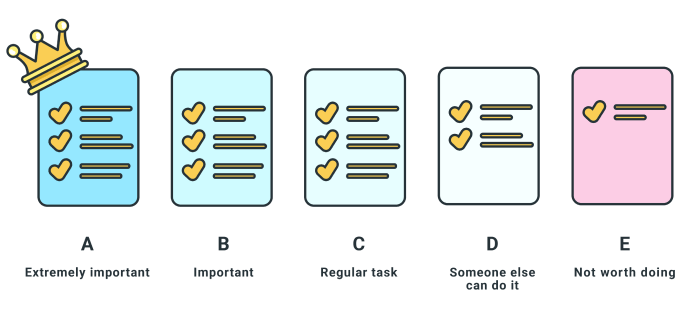
Key benefits of Eat That Frog
- You'll clear the rest of your daily schedule for easier tasks.
- You'll learn how to prioritize.
Timeboxing — for tackling tasks faster
Allocate specific time to activities to limit the time you spend on them.
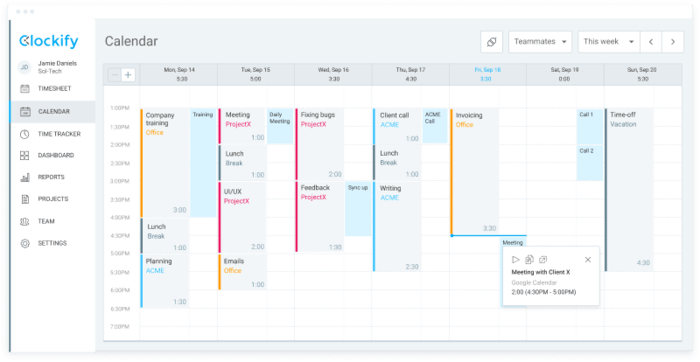
Key benefits of Timeboxing
- Timeboxing is great for small tasks you can't find the time to tackle.
- The method is also great for large tasks you can't find the motivation to tackle.
Time Blocking — for better planning
Allocate specific time to activities to find a place for them in your calendar.
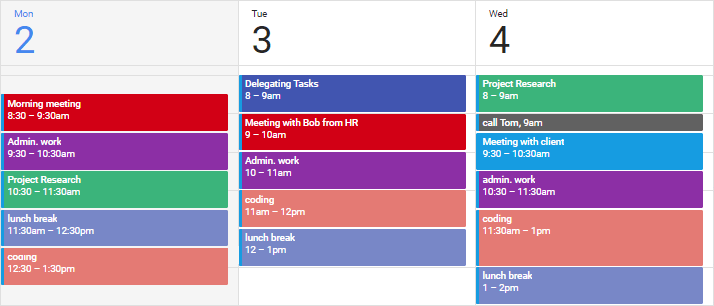
Key benefits of Time Blocking
- You'll immerse yourself in the task.
- You'll ensure you find time for any activity.
Inbox-Zero — for reclaiming your attention
Inbox-Zero is an email-centric approach meant to help you manage your inbox.

Key benefits of Inbox-Zero
- You'll specify and limit the time you spend on inbox management.
- You'll focus on priority emails.
Who's Got The Monkey — for successful task delegation
Who’s Got The Monkey is an approach meant to help you delegate by recognizing, assigning, insuring, and checking the progress made on tasks.

Key benefits of Who’s Got The Monkey
- Who’s Got The Monkey encourages managers to stop micromanaging.
- The method gives a clear overview of responsibilities and accountability in a team.
Action Method — for making goals actionable
View all your daily work as separate projects you'll parse and manage according to clear project management steps.
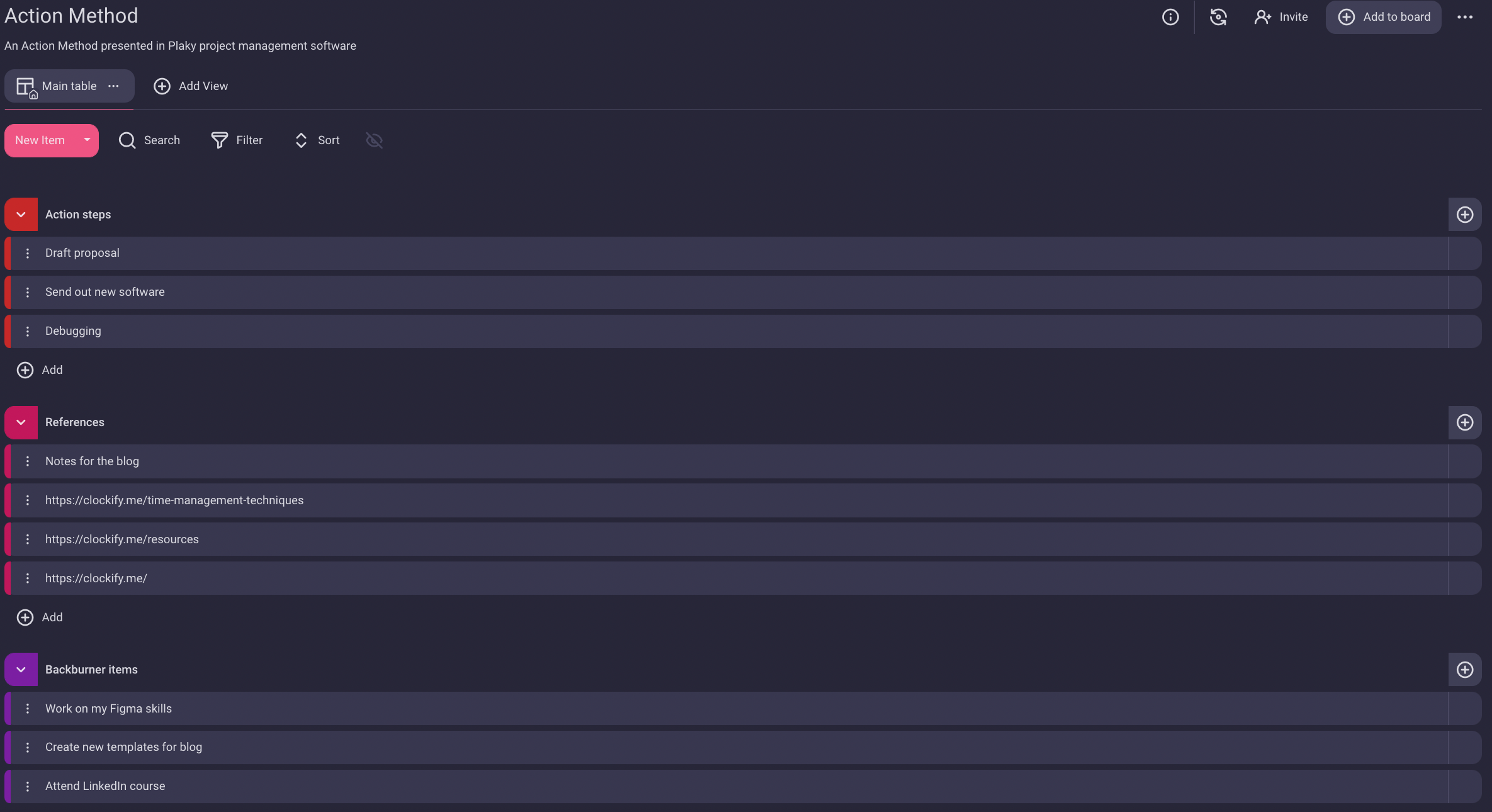
Key benefits of Action Method
- You'll be faster and more efficient.
- The Action Method provides a clear overview of the work you've done, and the work you still have to do.
The Eisenhower Matrix — for learning to prioritize
Prioritize tasks based on their levels of urgency and importance and then tackle them in the right order.
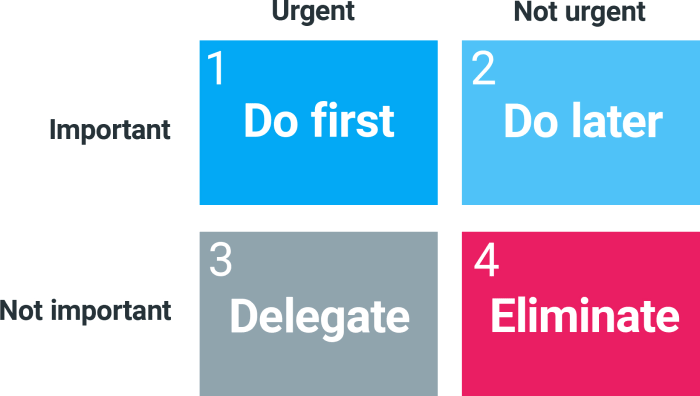
Key benefits of the Eisenhower Matrix
- You'll learn how to prioritize.
- You'll learn what types of tasks you can delegate or eliminate.
Biological Prime Time — for finding personal productivity peak hours
Analyze your productivity levels throughout the day, and work on priority tasks during your productivity peak hours.
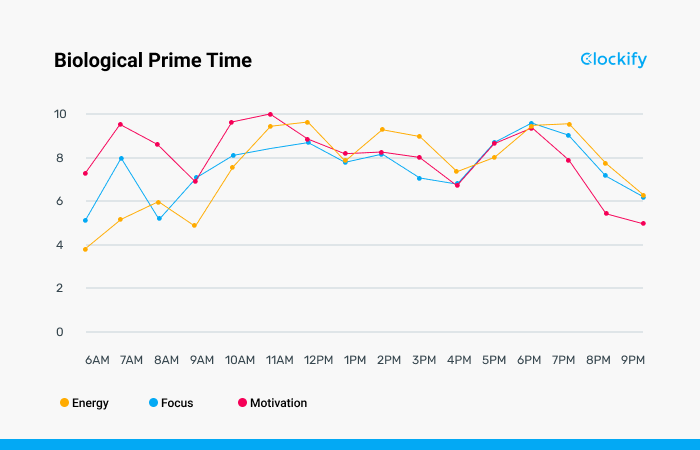
Key benefits of Biological Prime Time
- You'll learn to identify your personal productivity peak hours.
- You'll learn when to schedule priorities and non-priorities.
The Productivity Journal — for productivity and de-stressing
Write about the activities you've completed or need to complete in journal-like entries. You can use a productivity tracker app for this purpose.

Key benefits of the Productivity Journal
- You'll compile an archive of your personal productivity history.
- You'll decrease your stress levels.
The Seinfeld Method — for building good habits
The Seinfeld Method (aka Don’t Break the Chain) is a calendar-based system that encourages you to work on your professional skills a little bit every day and mark your progress in your calendar.

Key benefits of the Seinfeld Method
- You'll feel motivated to polish your professional skills.
- You'll be less likely to procrastinate with work.
The 10-Minute Rule — for easing into work
The 10-Minute Rule is a time-bound approach that lets you ease into your work by only working for 10 minutes for a start.
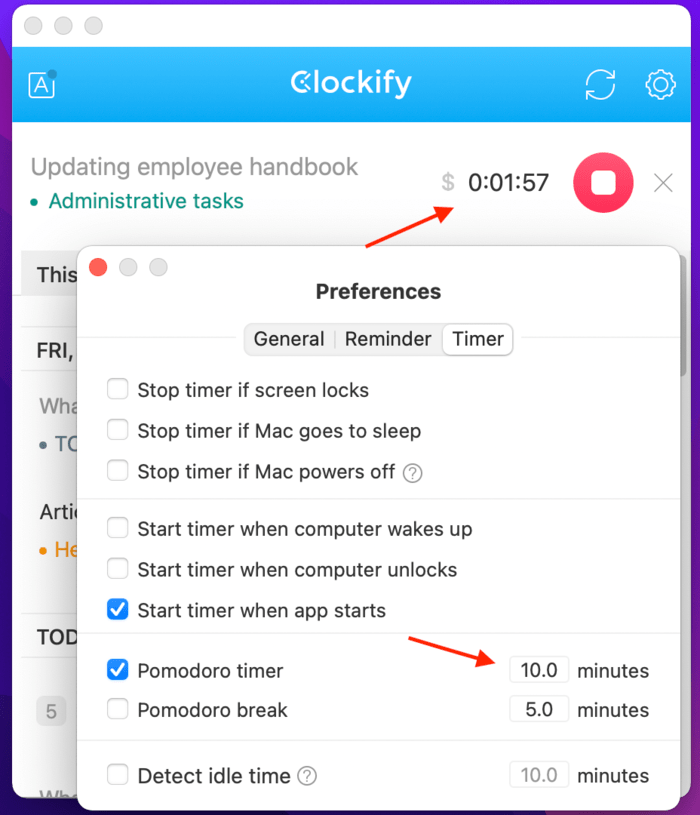
Key benefits of the 10-Minute Rule
- You'll find it easier to work on boring tasks because your schedule only obliges you to work on them for 10 minutes at a time.
- You'll parse your boring, long tasks into manageable chunks.
To-Do List — for better motivation
You list the tasks you've finished so far, for analysis and motivation purposes.

Key benefits of To-Do List
- Seeing a number of finished tasks checked off a list will motivate you to keep going.
- You'll better understand what you still have left to do.
To-Don't List — for eliminating distractions
You list tasks you need to refrain from doing, such as visiting Instagram during work hours.

Key benefits of To-Don’t List
- You'll mentally let go of time-consuming activities.
- You’ll finish your tasks sooner.
Flowtime Technique — for deep focus
Experiment with the time you allocate to different tasks using a free timer app. Test whether you work best in 10-minute chunks, 90-minute chunks, or anywhere in between.

Key benefits Flowtime Technique
- You'll have the freedom to decide how much time you'll spend working or on a break.
- Flowtime Technique is a highly customizable approach.
Top Goal — for consistency
You pick a priority goal and allocate time to accomplishing it every day.
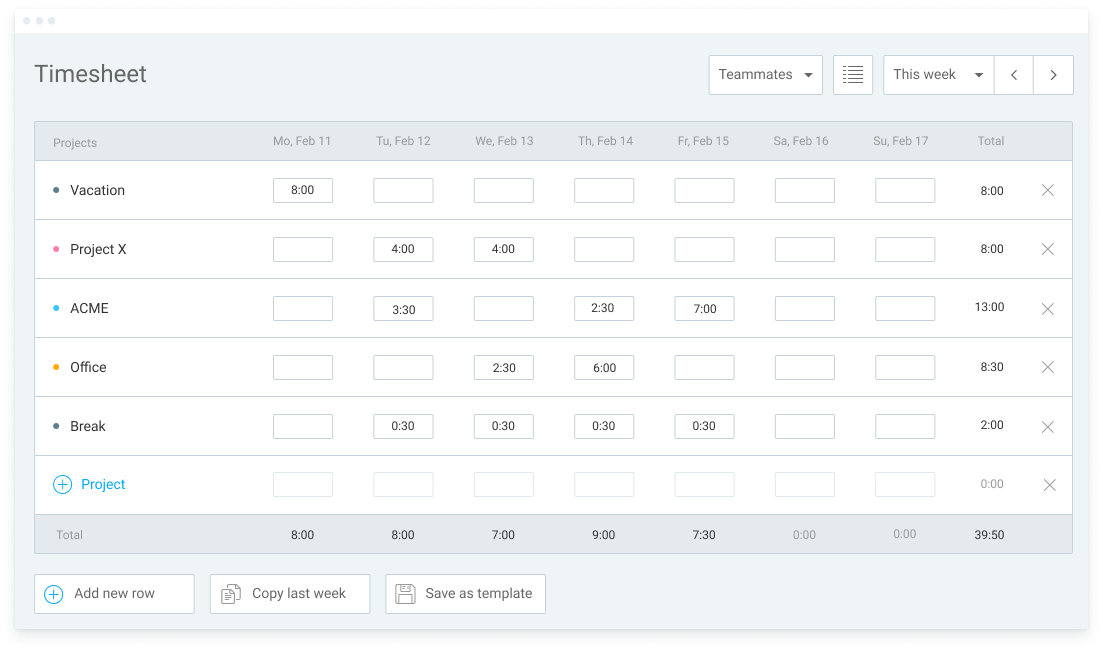
Key benefits of Top Goal
- You'll perfect the skills you need to reach said goal.
- You'll practice your ability to focus.
Pareto Analysis — for energy efficiency
The idea is to focus on 20% of your activities that bring the majority of your desired results (80%).

Key benefits of Pareto Analysis
- You can better prioritize your tasks.
- It helps you get the most out of your work.
Rapid Planning Method (RPM) — for better planning
RPM helps you identify your “results, purpose, and massive action plan”.

Key benefits of Rapid Planning Method (RPM)
- It helps you plan your immediate actions based on your long-term goals.
- It helps you break down abstract goals into manageable, concrete tasks.
Pickle Jar Theory — for easier task categorization
The Pickle Jar Theory helps you imagine your tasks as the contents of a pickle jar to better categorize them by importance:
- Rocks — the most important tasks
- Pebbles — task you can delegate or leave for another day
- Sand — distracting activities, e.g. checking your phone
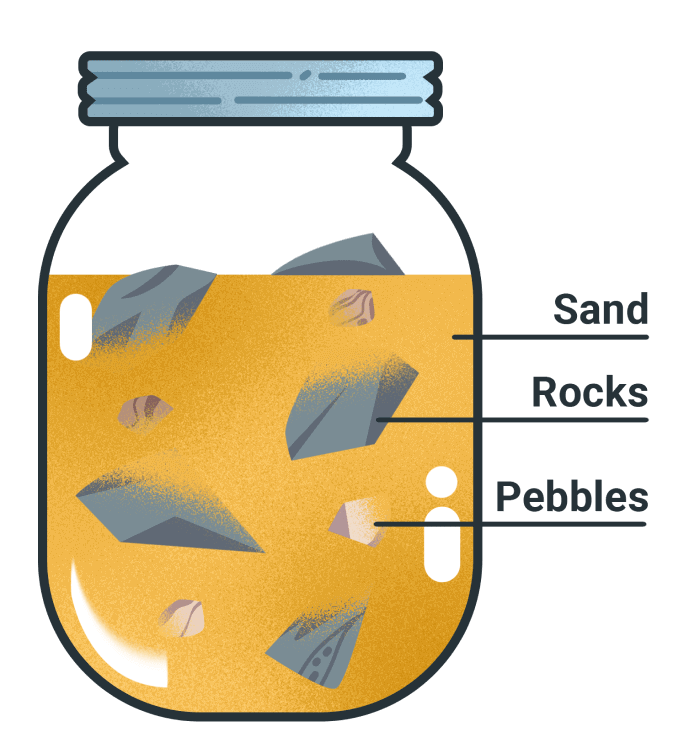
Key benefits of Pickle Jar Theory
- You’ll be able to better organize your workday so that you can finish everything on time.
- IT helps you eliminate distractions.
Deep Work — for solving complex problems
This strategy encourages you to fully focus on the task at hand and perform at your peak.
Key benefits of Deep Work
- It allows you to achieve sharper focus and produce high-quality results.
- It helps you hone your ability to solve complex problems that require your undivided attention.
ABCDE method — for better task management
This method allows you to organize your tasks into 5 categories based on their importance and decide how to handle them accordingly.
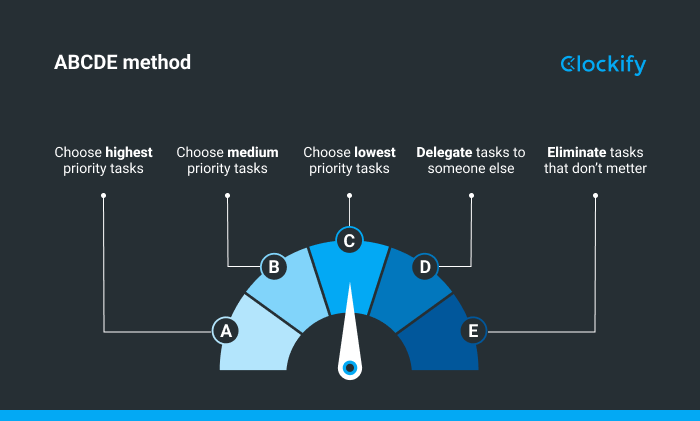
Key benefits of the ABCDE method
- You’ll be able to easily prioritize your tasks.
- You will have a clear picture of which tasks you can eliminate or delegate.
1-3-5 Rule — for better organization of your workday
This method encourages you to find 1 big, 3 medium, and 5 little things to focus on each workday.
Key benefits of the 1-3-5 Rule
- This method allows you to create a simple but comprehensive to-do list that’s easy to follow.
- You’ll have a clearer picture of your priorities for the workday.
POSEC method — for taking care of work by prioritizing well-being
The POSEC method stands for:
- “Prioritize by
- Organizing,
- Streamlining,
- Economizing, and
- Contributing”.
It is based on Maslow’s pyramid of needs. It encourages you to take care of your personal needs first so that you can move on to other responsibilities.
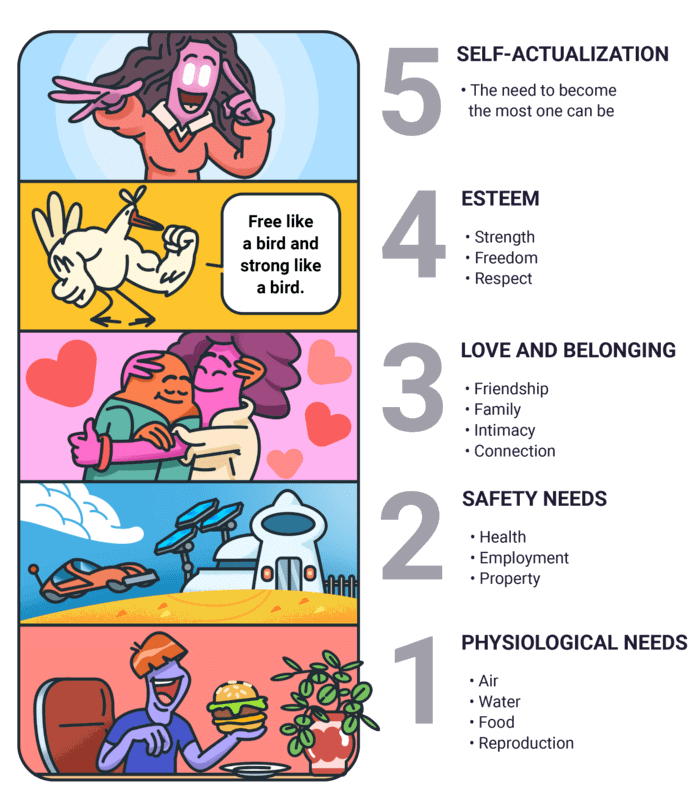
Key benefits of the POSEC method
- It acknowledges the fact we need to take care of ourselves before we can contribute to society, family, or work.
- It helps us make time for our leisurely activities.
Bullet Journal (BoJo) — for an all-encompassing view of your work
The Bullet Journal method helps you keep better track of your past, present, and future activities.
Key benefits of Bullet Journal (BoJo)
- It helps you align your long-term and short-term goals.
- It gives you a clearer picture of your job performance in general and any areas that need improvement.
Time Management Tips
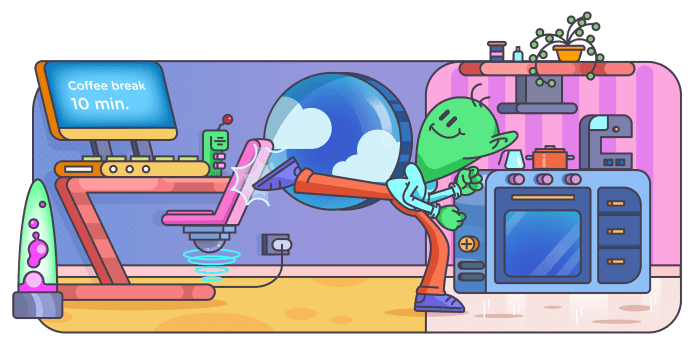
54 Time management tips for improved work and life routine
Time management strategies have only half of their effect if you don’t follow the right time management tips for work.
So, here are the best time management tips for remaining in control of your time at every stage of work.
We also offer tips on how to stay healthy and focused — and see what works best for your time management routine.
Time management tips for preparation and planning
Proper time management starts even before you begin working.
Here are some tips to help you prepare and use every moment of your time wisely.
Find your most productive time
The entire day simply isn’t optimal for work, and you’ll need to analyze your time usage to find your own ideal biological prime time.
You can turn to Clockify to track the time you spend on tasks for later analysis:
- Track the time it takes you to finish one type of task in the morning.
- Then, try tackling the same type of tasks in the afternoon tomorrow.
- Compare the results.
If it takes you 2 hours for this type of task in the morning, and 1 hour in the afternoon, you’re just not a morning person and should handle your priorities later in the day.

Find your time management personality
Identify your personality type based on how you (mis)handle your time. You may be:
- Time Martyr — the person who can’t say no, so they run out of time for important tasks,
- Procrastinator — the person who puts off doing their tasks,
- Firefighter — the person who views every task as a priority and, consequently, can’t focus on anything,
- Underestimator — the person who keeps breaking deadlines due to underestimating the time needed to complete tasks.
Once you identify your time management personality type, you can work on your weaknesses using a suitable strategy.
How to say “No” at work and save time for priority tasksDesign a suitable work environment
Whether you work at home or in a traditional office, you can optimize your work environment so that it promotes focus and minimizes distractions.
You can find tips on how to achieve that further on in this guide.
Plan your day the night before
Planning your day the night before helps you start a new day with peace of mind.
You’ll be able to think about your priorities and organize your schedule accordingly, without rushing anything.
Make your schedule flexible
You never know when something unexpected (but important) will pop up — so make sure to always schedule an extra hour in your calendar, just to be on the safe side.
Create to-do lists
You’ll stay on track with your daily tasks and feel a boost of morale and motivation each time you check off an item from your to-do list.
 Motivation guide: How to get and stay motivated
Motivation guide: How to get and stay motivated
Set deadlines for your work
Deadlines tell you when you need to finish a task, so it’s a good idea to plan your time accordingly.
Parsing a task into subtasks and assigning a deadline for each serves as a great motivator to help keep you going.
Time management tips for task execution
When you’ve done everything you can to properly prepare, it’s time to do the actual work.
Here’s how to make the clock work for you while managing your tasks.
Track time for each task
Knowing how much time you spend on each task can tell you how productive you really are.
It also helps you make more accurate time estimates for future work — so you’ll save time in the long run.
For this purpose, you can use timekeeping software such as Clockify.
Go to the Time Tracker page, write the activity you’re working on in the "What’s up" box and start the timer.
Once you’re done, turn off the timer.
Repeat the same routine until you’ve finished with activities for that workday.
Then, go to the Dashboard page, and take a quick glance at how productive you were in terms of hours tracked per day.
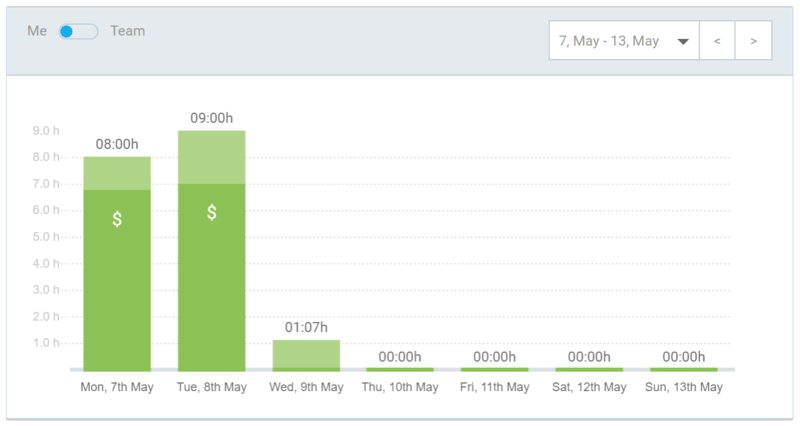
Do the most important task first
Not all tasks are equally important or urgent. You’ll want to avoid working on trivial tasks during your productive peak time or spending too much time on them.
Instead, start with the most important task for the day while your focus is still sharp.
Set reminders before each task
Reminders help you keep track of the work you have to perform.
If you set an alarm at least 15 minutes before it’s time to attend a meeting or hold a presentation, you’ll give yourself enough time to prepare.
Don’t multitask
Multitasking may seem like a good idea, but it’ll only ensure you perform subpar on several tasks, instead of finishing one activity with the best results.
While multitasking, you won’t finish more tasks in the same amount of time it takes you to finish one task, but actually lose time by switching between activities.
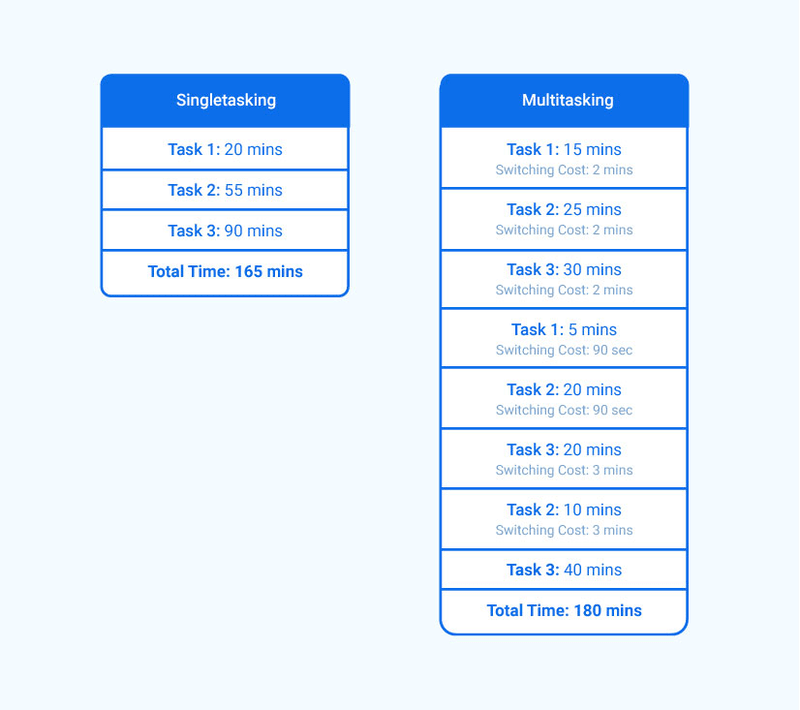 How to switch between projects and tasks without losing productivity
How to switch between projects and tasks without losing productivity
Group small tasks
Tiresome, but unavoidable mosquito tasks are a real pest.
Group them together into one time block and enjoy the feeling of having a dozen new, motivating checkmarks on your to-do list in no time.
Give yourself enough time to finish
If you rush a task, you will likely do a second-rate job. You’ll aim to finish faster, but you’ll likely just spend even more time trying to fix the mistakes you’ve made.
It’s better to take breaks when you feel like you’re losing patience with a task and then return to it with a clear head.
Put a checkmark in front of every task you finish
Creating a to-do list is important, but tracking the tasks you’re working on can bring you motivation to keep going until the list is completed.
That’s because putting a checkmark in front of finished items helps you feel accomplished and more in control of your daily workload.
20% of input brings 80% of results
The 20/80 rule, known as the Pareto principle, shows that it takes only 20% of your efforts to reach 80% of all your results.
When setting goals, don’t look at individual tasks, look at the big picture — what goals are so important that once you reach them, you’ll be able to call the day a success?
Single out these goals and the tasks you have to perform to reach them — and focus on finishing these tasks first.
Time management tips regarding breaks
All work and no breaks make Jack a burnt-out boy. While that’s not exactly how the saying goes, breaks are essential for time management.
Here are some tips on how best to use them.
Take regular breaks
Breaks are important for progress. They help you recharge batteries for another work session, so make sure you take at least 5- or 10-minute breaks from time to time.
You can even schedule breaks to make sure you don’t skip them.

Change your environment while on a break
Sticking around your workspace when on a short break may be the easiest — but not the most effective practice.
Instead, you should change your surroundings to tell your brain it should unwind and relax during this period.
Don’t skip your meal breaks
To stay productive, you also need to eat healthy and on time.
Trying to power through tasks when you’re hungry won’t help you finish faster — but will only tire you out.
Use a break to stretch and move around
The best way to reset from hard mental work is to give your mind a rest and engage in some light physical activity.
You don’t need to do much — take a short walk around the block, fold some laundry, or do a jumping jack or two.
When you return to your desk, you’ll feel refreshed — and maybe find that you have a solution to a work problem because you’ve given your mind a break.
10 Productivity exercises for body and mindUse a break to mediate
Meditation is a great way for you to unwind and relax, and you can even use meditation time to make better decisions.
An INSEAD Business School research suggests mindfulness meditation makes your thinking more rational, so it helps you make better decisions.
Time management tips for dealing with distractions
Distractions are the number one enemy to efficient time management and productivity.
Here’s what you can do to eliminate or at least minimize them.
The most common workplace distractions and tips on how to tackle them | How to focus better at work: 20 effective ways to stay focusedIdentify time wasters and track the time you spend on them
Once you identify and list time wasters, track the time you spend on them — you’ll get an idea of the exact amount of time you can allocate to more important activities during your workday.

Use the 20-foot rule
The 20-foot rule applies to phones, tablets, and similar distractions.
If you constantly procrastinate on your phone while working, perhaps you should put it at a safe distance, so it doesn’t tempt you.
Just put your phone at least 20 feet from where you’re working.
Sure, you may feel the urge to go the distance and check your phone — but after a while, the activity will become tiresome, and you’ll stop.
Don’t let people interrupt you
When you gain momentum at work, the last thing you need is someone interrupting you.
This may be only a short interruption — but you’re bound to lose focus, which isn’t easy to restore.
You can let the people in the office know they shouldn’t disturb you at a certain time or turn on Do Not Disturb mode in your team chat app.
You can also implement the Inform/Negotiate/Call Back method:
- Inform the other party that you’re busy at the moment.
- Negotiate the time when you’ll be able to address the other person’s issue.
- Call them back at the arranged time.
This way, you won’t break your work focus — and you’ll also put the other person at ease.
Use a website blocker
Sometimes, you simply need to fight your own urge to browse endlessly through social media.
A website blocker will make sure you stay away from time-wasting websites during the time designated for work.
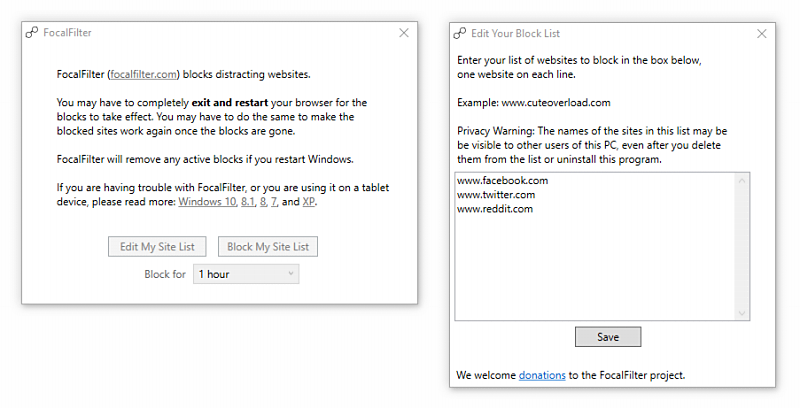
Unplug from the Internet
At other times, your urge to procrastinate is so strong that you find yourself reading about state labor laws in Nevada (despite not living there) just to avoid your real work.
In such desperate times, drastic measures are called for — unplug from the Internet and save yourself from the temptation.
Time management tips for efficient phone calls
If the nature of your job requires you to be on your phone a lot, constant calls can keep you from getting anything done.
Here’s how to manage your phone calls so that they’re not overly distracting.
If possible, plan your phone calls
Although you can’t predict when someone will call you, you’ll save a lot of time if you plan when you’ll call your clients.
Pick the time of day when you’re less likely to perform productive work — if you’re a morning person, allocate the phone calls you’re supposed to make to late afternoons.
Before that time, focus on more important activities.
Plan what you want to say
Prioritizing and carefully phrasing what you have to say in a phone call makes you more concise and less likely to stumble on your own words.
Make short notes on the most important points you want to convey.
Make your sentences short and clear, and ensure you’re informative.
This way, you’ll finish the call faster and minimize the need for a second call about the same topic.
Summarize what you have agreed on with the other party
It’s important that you’re clear on what the final points of your agreement with the other person are.
This way, you’re less likely to feel unsure about the end deal — so you’re less likely to waste time on making another call.
While talking, jot down some of the main points of the conversation in your notebook.
Once you notice the conversation is nearing its end, summarize the main points with the other person to confirm everything is clear.
If you’re constantly answering the same questions, keep a FAQ note nearby
If various callers tend to ask you the same set of questions, keep a note with the most frequent questions and their answers nearby.
This will save you a lot of time — because you’ll automate a part of most phone call conversations.
You can write down these questions and note in 2–3 variations of your answers, which you’ll then be able to rotate with different clients — depending on their specific needs.
Time management tips for managing emails
Emails can be a huge time sink if not managed correctly.
Here’s what you can do to avoid that.
How to manage email productivity: Tips from Patty Kreamer, a professional organizerUnsubscribe from emails you never read
Inbox clutter slows down your daily email check-ups because you sometimes have to scroll up and down over and over again trying not to miss the email you’re expecting.
The best time-saving practice is to simply unsubscribe from emails you never or rarely read.
Unsubscribing manually can take some time, so it’s best to let an app do it for you. Unroll.me is a nice option that shows you a concise list of your email subscriptions and lets you unsubscribe from irrelevant emails with a click.
Whitelist and blacklist email addresses
Spam mail can be a huge problem, but every email client allows you to whitelist or blacklist certain email addresses or even entire domains.
For example, in Gmail, you can simply block the sender of annoying mass emails and never get their emails again.
On the other hand, you can also create filters that will ensure emails from important senders and domains never end up in spam and are always marked as important.
By regularly whitelisting and blacklisting senders, you ensure your inbox is clutter-free and easy to navigate, saving you a lot of time in the long run.

Keep responses short and to the point
Longer emails may cover all the details — but shorter responses take less time to write and are usually more clear and concise.
For short, concise emails, include:
- Clear email purpose
- Really brief introduction
- Clear points
- Short words and sentences
- No more than 5 sentences
- Short and pleasant closing

Timebox your inbox
You may feel the urge to check your inbox every time you receive a new email — and all those interruptions will take away from your focus on real work.
But, if you set a strict timebox each day — for example, one hour in the morning — and make sure you stop managing your inbox as soon as the timebox expires, you’ll limit the time you spend on this secondary activity.
Track the time you spend on emails
Emails are one of the biggest time wasters for working people, and it’s important that you know how much time you really spend managing your inbox.
This way, you’ll know how much time you could allocate to more important activities.
Use a time tracker like Clockify to track the time you really spend on emails via a timer.
Just create an “emails” tag, and do the following each time you start working on your inbox:
- Create a time entry for it on the Time Tracker page, and
- Attach the "emails" tag to it.
Log your email time each day for a month, and then go to the Summary report to see how much time you spent managing your inbox that month.
Time management tips for meetings
Meetings can take up a lot of our time and seriously disrupt our workflow.
So, if you’re in charge of organizing them, here are some tips on how to make them as efficient as possible.
How to make meetings more productiveAlways have meetings at the same time of the day (or week)
If your meetings happen at random and your team members never know when they’ll happen in advance, you risk disrupting everyone’s schedule and focus.
Likewise, an unexpected meeting might interrupt a team member’s deep work time and make it harder for them to pick up where they left off before the meeting began.
If possible, pick a specific time of the day, or a particular day of the week, for meetings. This way, everyone will know when to expect them and plan accordingly.
Plan an agenda in advance
Decide on the main points you and your team should go over in the meeting in advance because the conversation will be less likely to veer off and take up more time.
Determine the meeting objective and stick to it.
And, most importantly, set the approximate time for each topic so that you stay on track at all times.
Use meetings for collaborative activities
Meetings are perfect for collaborative activities, such as brainstorming.
You’ll have all the relevant people in one place (virtual or physical) and save the time it takes to get everyone’s opinion outside meeting time.
Health tips for better time management
An often overlooked aspect of time management is taking care of your health.
The connection may seem far-fetched, but if your mental or physical health is on the decline, your performance will take a hit as well.
Here’s how to take care of your health so that you can stay productive.
Exercise regularly
Exercise improves health overall, but it also helps you perform better at your job.
According to a study on the effects of exercise on work performance, exercise can improve employees’ performance and time management by as much as 72%.
Never skip breakfast
We’ve already touched on the importance of not skipping your meals, but it’s worth stressing out that breakfast is the most important meal of the day.
People tend to skip the morning meal because they’re often in a hurry to get to work.
But, starting your workday on an empty stomach will make you feel tired as breakfast gives your brain the energy to start working.
Get enough sleep
You may think it’s a good idea to take time from your sleep to do more work during the day, but this is a counterproductive practice. Working while underslept will negatively affect your job performance.
According to Sleep Foundation, sleep deprivation will make you:
- Unable to maintain focus
- More prone to making errors and omissions
- More vulnerable to stress, irritable, and even angry
- More prone to developing anxiety and depression
So, make sure to get about 7 to 9 hours of sleep each night for the best results.
Stay hydrated
Apart from exercise, food, and sleep, another factor that may influence your performance is not drinking enough water.
In fact, a study conducted at the University of East London shows that drinking water expands gray matter in the brain. According to the same study, staying hydrated makes you up to 14% more productive.
Time management tips for your free time
Your free time should not be about work. But, there are still some simple things you can do — perhaps when you’re bored — to make time management easier come work time.
Organize your files, folders, and documents
An organized desk and computer save the time you’d otherwise spend looking for an important document you have no idea where you stored.
At the end of each day or workweek, you can allocate some time to sorting out your newest files, folders, and documents.
How to declutter your digital spaceRead for pleasure
Reading for pleasure is not only fun, but it can make your brain sharper.
Researchers agree that reading a book is beneficial for your brain and health overall — it keeps your mind sharp, reduces stress by 68% percent, and increases intelligence.
Make weekly work reviews
At the end of the week, if you review and analyze what you’ve done so far, you’ll gain a better understanding of what you still need to do when the next week starts.
Define weekly goals
Clearly defined goals will help you organize your mental space and get ready for the week ahead.
It’ll be easier for you to define goal-related tasks and then allocate them to a specific day and time of day — to complete them before deadlines.
Work 2–4 hours on weekends
If you’re a freelancer who doesn’t mind working on weekends, you can use that to your advantage.
Spending up to 4 hours during the weekends on work will help you ease the workload for next week — but still leave enough time for fun weekend activities.
Plan your meals and outfits for the week ahead
Thinking about meals and outfits 10 minutes before you need them can be both time-consuming and stressful — especially if you’re in a hurry.
So, planning in advance is bound to help you and even save you more time for enjoying your meals or your morning rituals.
Unwind and relax
You can’t (or at least shouldn’t) think about work all the time — take some time to relax before going to bed every day.
You’ll clear your head and give yourself some precious me-time.
Your work will still be waiting for you in the morning, anyway.
Additional time management tips
If none of the above helps, try one of the following additional tips on how to excel at time management.
Don’t visualize your success
According to a study on positive visualizations of the desired future, positive visualizations — in which you see yourself succeeding — drain the energy out of your ambition. This way, they actually make you less likely to succeed.
If you see yourself reaching your end goal, your brain will believe you have already reached it — and you’ll lose your drive and focus.
Instead, the same research suggests you try critical visualizations — think about your obstacles and setbacks and try viewing potential failure as something normal.
This way, you’ll stay alert enough to remain focused — but feel less stressed out about the outcome of your task.
Avoid being a perfectionist
Tweaking a task to perfection is essentially a whole new level of wasting your time.
Nothing will ever be perfect in the eye of a perfectionist, so you’d be better off if you were to stop working on a task once you’re truly done — and then allocate this extra time to the next task.
Do some work during commutes
We usually think long commutes to work are simply a waste of time.
But, you can use this time to listen to podcasts, take online classes, or even finish some work before arriving at the office.
Interesting facts about commutingPractice deep work
Cal Newport’s concept of deep work involves concentrating on a cognitively demanding task in such a way that helps you work on it longer, finish it faster, and avoid distractions along the way.
Learn and use keyboard shortcuts
Almost every browser and operating system have its own set of keyboard shortcuts for almost every operation.
Although it would be tricky to learn all the shortcuts for the browser and operating system you use, you’ll save yourself a lot of time if you learn the basic ones.
Make your most important tasks into habits
For example, creating the outline for new content on your blog can become just as natural and easy as brushing your teeth.
You’ll just need to:
- Establish the precise steps to crafting an outline,
- Allocate a certain amount of time to it, and
- Follow the steps and stick to the schedule.
This applies to any type of task.
Time management tips for students
As much as proper time management can prove tricky for employees, it can prove even trickier for students. So, here are some of the best tips to live by during exam season:
Track study time
Tracking the time it takes you to master a subject helps you keep your focus. Analyzing data via a time tracking app helps you find your productivity peak hours and streamline your study-related time management efforts in the future.
If you track time, the ticking timer encourages you to stay focused on studying during the time you've allocated for this subject. It also becomes easier to plan and implement regular breaks.
If you track time, it will be easier to understand when you're the most efficient, and when you should schedule your most difficult subjects, most tiresome passages in your study notes, or most demanding assignments overall.
If you track time, you'll have data showing:
- What topics you've finished so far,
- How much time you've spent studying in total and by subject, and
- Whether there were time periods you've wasted.
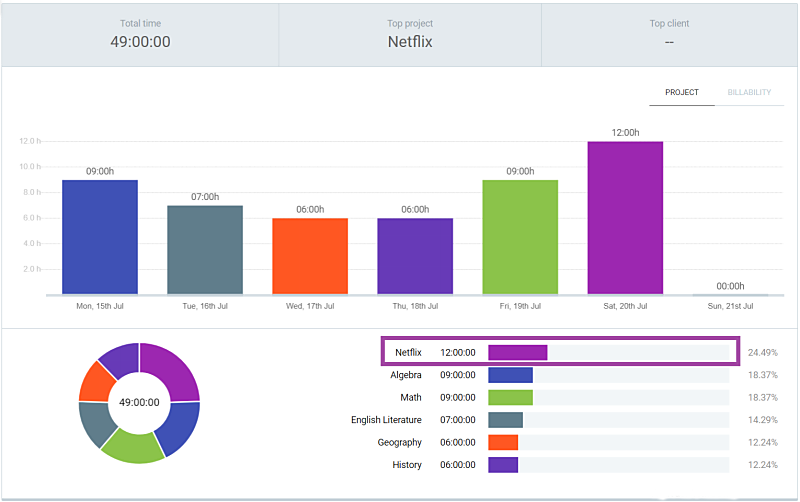
Take study breaks
Studies show that the mind cannot concentrate on a task in one go for more than 90 minutes, so you shouldn't study for longer than that without taking a break.
So, take 5 minutes at least, and 20 minutes at most in one go. Have a quick snack, go outside and take a short walk, or initiate a brisk conversation with your roommate.
Make sure you take a break for a nutritious meal when you're feeling hungry, and go to bed on time. Studying for 12 hours each day is possible, but it'd be counterproductive, not to mention unhealthy, if you were to forgo sleep and rest altogether.
So, sleep at least 7 hours per day at night (if not more), and don't refrain from taking naps from time to time. One Harvard study shows that taking a short nap after a study session helps you retain what you've just learned.
Motivate yourself with 2-minute study time
If you're having trouble diving into a subject, start by allocating only 2 minutes to this subject.
Study for 2 minutes, and continue studying past the 2 minutes only if you feel comfortable enough to continue. Otherwise stop, and try again later.
Despite having a choice, most students will continue studying after the predefined 2 minutes because it's usually the most difficult getting started.
Lock your phone during study time
Answering messages, making phone calls, browsing through your social media feeds, and taking selfies hashtagged "study mode" is a common time-wasting tactic during exam period. And, it's usually your phone that's the problem.
If leaving your phone at the dorm room isn't an option, then you'll need to lock yourself out, to avoid online temptations.
For this purpose, you can enlist the help of an app. For example, Flipd lets you lock your screen during a period of time you choose. You can decide to lock your phone for 1 hour, 4 hours, 8 hours, 12 hours, or a custom period.
You can even use the Full Lock option which automatically hides your apps, feeds, and games from you, until the selected time is up.
Use a calendar
A calendar helps you plan, organize, and schedule your study time.
Mark "deadlines" (exam dates) in your calendar, and then plan your schedule accordingly:
- Parse the subject you have to study for by topics and subtopics.
- Allocate a fixed time to each topic and subtopic every day before the exam (in such a way that leaves you with at least a day of spare time for unexpected problems and revision).
- Stick to the schedule.
A calendar helps you keep track of your work, and you'll be guaranteed to pass the exam, if you only stick to your plan.
Learn according to your learning type
Not everyone learns the same. There are 4 different learner types, and each has an optimal study method:
- Visual type — This type learns best from visual study materials. They best remember the data they see in infographics, charts, and tables.
- Auditory type — This type learns best by listening to information spoken aloud. They best remember the data they hear about in lectures, audiobooks, lessons, and class discussions.
- Kinaesthetic type — This type learns best through experience. They best remember the data they infer from experiments, science projects, and practical tests.
- Reading/Writing type — This type learns best by taking notes and reading said notes. They best remember the data they've written and then re-read a couple of times.
Schedule rewards
If you've spent the entire day studying, AND managed to understand a number of difficult concepts along the way, it's high time you reward yourself. Rewards serve as a motivator to keep you pushing forward.
It'll be much easier to focus on your work if you know there's a light at the end of your "study" tunnel in the form of a movie night out with friends.
Student guide to productivity.Tips on how to create an effective time management environment
Effective time management isn't just about the time management skills you possess and the time management tips and strategies you follow — it's also about the environment you work in. Here's how to make your office into a productivity paradise, no matter whether you work from home or at the company office:
Choose the right colors
Predominant colors in your office, such as the color of the walls, have a psychological effect on you — and several colors are a suitable choice:
Red
Great if your job is physically demanding. The color raises your pulse rate and makes you more alert.
Blue
Great for traditional office workers — its presence soothes you, helps you calm your mind, and aids concentration.
Yellow
Great for entrepreneurs — its presence boosts optimism about your decisions.
Green
Great for innovators — its presence encourages creative thinking and facilitates a sense of calmness.
In a company office: You can't decide on the color of the walls in your company's office, but you can introduce the right colors on a smaller scale. Get some artwork or a desk picture that’s in the right colors.
In a home office: You have the freedom to decide the color of your walls, and make decisions about the overall color scheme. Make the color of your interior design reflect the state of mind you want to pursue in work.
Make sure there's plenty of light
Bad lighting in your office causes fatigue, and even physical problems such as eyestrain, headaches, and migraines — so, make sure your lighting is optimal.
In a company office: Opening the windows at work usually isn't an option, and opening the shutters may bother some of your colleagues. So, if your office isn't light enough by proxy, bring in your own lighting. LED lights have an effect closest to natural lighting, so they're your best choice for a small, but effective lamp.
In a home office: Once again, you have more options to tweak your environment if you work from home. So, use as many lamps as you want, open as many windows as you need, and open as many shutters as you can.
Make the most of your chair, desk, and computer
Optimal comfort leads to higher productivity and focus at work. So, your chair should be adjustable, and your desk the optimal height:
- Your feet should be able to touch the floor or at least the footrest of your chair.
- Your monitor should be positioned either at your eye level or below it.
- Your computer should be at least 24 inches (~60 cm) away from your eyes.
Most chairs and desks are not ideal, but some tweaks will make your workstation more suitable, per the above-listed rules.
In a company office: Most companies nowadays offer adjustable chairs to their employees. You can also bring in some pillows, or anything else meant to help you feel more comfortable. Most companies offer risers meant to help keep your computer screen at an optimal eye level, but you can also bring your own.
In a home office: Invest in an adjustable chair and a sturdy desk. Standing desks are often recommended, but a study shows that there are detrimental cognitive effects of standing while doing computer work. So, you better work while sitting down, and choose a suitable desk for it.
Maintain optimal room temperature
You can't work properly if it's too cold or too hot — although, one study shows that at least women are more productive in warmer offices. The Occupational Health and Safety Administration (OSHA) recommends a workplace temperature of 68–76 degrees Fahrenheit (20–24.5 degrees Celsius), so try to keep it that way.
In a company office: If your office doesn't have an air conditioner everyone is free to regulate, you'll need to bring your own fan or space heater. If your colleagues like it colder than you do, you can bring a jacket or sweater to work, to wear when you need to.
In a home office: You can open the window or adjust the air conditioner when it's hot, or bring in an extra heating body when it's cold.
Scent the office
Certain smells can boost your productivity, and help you make the most of your schedule.
Some great choices are:
- Lemon scent — improves concentration and calms you when you're feeling anxious or angry,
- Jasmine scent — stimulates your nervous system and energizes you as a result,
- Peppermint scent — boosts your energy and helps you think clearly,
- Rosemary scent — improves memory retention and helps you fight off exhaustion,
- Cinnamon scent — improves concentration and focus, as well as helps you battle mental fatigue.
In a company office: Bringing in a scented candle to work likely won't be met with approval from your colleagues. So, it's best that you bring a small scented bag or a bottle of essential oils you can take a whiff of from time to time.
In a home office: You'll have the freedom to light as many scented candles as you want. Another efficient solution is to simmer aromatic herbs in your kitchen, and let the pleasant scent slowly spread throughout your home.
Introduce plants
Green offices are more productive — so, make sure you introduce plants to your work environment.
In a company office: Some company office settings aren't suitable for a plethora of plants, so you may need to be creative. Bring a small plant to your desk (such as a succulent), go to the nearby park during breaks, and put a lush forest as your desktop wallpaper.
In a home office: You'll likely be able to introduce more plant life while at home. You can even create a green corner with several fragrant herbs, and introduce natural pleasant scents, all while staying green at the same time.
Manage noise
Noise is the No. 1 enemy in your quest to create the optimal work environment. There are several ways you can deal with this problem.
In a company office: If outside noise is the problem, try headphones. You can then listen to productivity-enhancing music. Alternatively, your team can introduce a silent hour each day, when no one is allowed to talk, schedule meetings, or interrupt colleagues. This practice can facilitate focus and concentration, and help you be up to 23% more productive.
In a home office: Sometimes, the complete silence you typically find at a home office can be just as distracting as chatty colleagues. To manage the noise of your own thoughts, you can try a noise generator such as Noisli or MyNoise and bring your mind into a focused state by listening to the sounds of nature, purring cats, or a moving train.
Personalize your work area
As previously emphasized, feeling comfortable at your office helps you be more productive. And, nothing makes you more comfortable in your office than personalizing your workspace.
In a company office: By proxy, offices are a more impersonal working environment than home offices. But, you can personalize them with desk pictures, small plants, personal gadgets, a screensaver showing your family or friends, or the mug your friends picked out for your birthday.
In a home office: Home is the place where you can personalize your office space to the max. Decorate the room as you like, bring your favorite comfy sofa for those quiet moments of rest, and introduce a blackboard where you'll write checklists or inspirational quotes.
Have refreshments within reach
We've already covered how hunger and thirst can make you unproductive and disorganized. So, it's best that you keep refreshments and snacks within reach at all times.
In a company office: You can bring your lunch from home or have it delivered directly to the office. You're also advised to keep chocolate bars and cookies at your desk, in case hunger strikes with no warning. Most companies offer coffee, tea, sparkling and regular water on the spot, so you'll be covered in this area.
In a home office: While working at home, you'll be free to go get a cup of coffee or tea whenever you want, which can distract you from your work — unless you're prepared. So, it's best that you keep refreshments within reach. Fill up your cup of coffee, put a bottle of water at your desk, and lay out some snacks on a plate nearby.
Facilitate great ideas
Ideas are worth nothing if you don't note them down. So, make sure your office has efficient outlets for your Eureka moments.
In a company office: Keep a notebook and pen on your table, to scribble down your creative thoughts during the day. Use post-it notes when you find a great link you want to check out later, or a mind mapping app to capture and analyze your ideas.
In a home office: Notebooks and post-it notes work great at a home office as well, but you can enhance your note-taking efforts even further. Considering you're the only one physically present at your office, you can freely use a whiteboard to capture all your ideas, and in as much detail as you want.
Time Management Tools

Best time management tools to help improve time management
To help you make the most of your time, we finish this time management guide with a list of handy tools. They’ll help you streamline your time at work, your communication with colleagues, as well as your daily agenda, all while staying completely focused on priorities.
So, here are some of the best tools to help you in your time management efforts:
Clockify

An all-inclusive employee time-tracking software, great for helping you keep precise work hours, calculate your billable hours, identify time wasters, gather payroll data, and more.
Pumble

A powerful collaboration tool where you can communicate with your colleagues in real-time even if you’re a remote team.
Plaky

Free task and project management software that lets you better organize your work, coordinate with coworkers, track your progress, and more.
Remember The Milk

A versatile task manager, great for helping you go through business and personal tasks in your daily to-do lists.
Forest

A green focus app, great for helping you stop procrastinating on your phone by making you responsible for a virtual forest (and even letting you plant real trees, in a way).
Clara

An email-based meeting scheduler, great for helping you arrange and coordinate meetings with your peers.
Flow

An efficient project and a team manager, great for helping track the progress you make on tasks, as well as facilitating tasks with subtasks, notes, and comments.
My Life Organized

A robust task manager and organizer, based on the Getting Things Done time management approach, great for helping you manage your tasks and to-do lists.
RescueTime

A simple automatic productivity tracker, great for helping you analyze how much time you've spent on various websites and software.
My Noise

An exhaustive noise generator, great for helping you stay focused on work, while the soothing sound of white noise helps block all outside distracting sounds.
Epic Win

A fun RPG game-style task manager, great for helping you focus on your priorities by practicing your gaming skills.
Kiwake
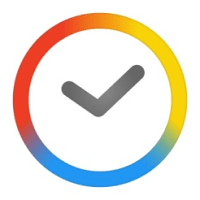
An unconventional alarm clock, great for helping you wake up by making you prove you're out of bed (and by having no snooze button at all).
Nimbus Note

A simple, yet effective note manager, great for helping you keep and share notes on various topics.
Join.me

A collaborative online meeting scheduler, great for helping you set up or join web conferences, and participate in text chats.
Syncback

An effortless online backup software, great for helping you save, sync, and restore your data automatically.
Bear

A simple, cloud-based note-taking app, great for helping you express your ideas and thoughts, and then turn them into practical task lists.
Loop Habit Tracker

An aptly named open-source mobile habit tracker, great for helping you cultivate good habits and work on reaching your goals.
Focus@will

An energizing collection of neuroscience-based music for productivity, great for helping you stay focused on your work, all to the sound of soothing instrumentals.
TimeTree

A straightforward shared calendar app, great for helping you schedule, coordinate, and attend events, in agreement with your colleagues, friends, and family.
Mind42

A refined mind mapping tool with collaboration features, great for helping you define, visualize, and organize your great ideas during brainstorming sessions.
Taskade

A comprehensive task manager and collaboration tool, great for helping you work on your long-term and short-term goals.
Instapaper

An elegant bookmarking service, great for helping you save interesting content you find online for later reading, either during work commutes or while waiting for doctor's appointments.
SaneBox

A systematic email manager, great for helping keep your inbox decluttered, and your priority conversations organized.
IFTTT

A conditional statements creator, great for helping you define conditional automations between devices, services, and apps.
Best time management apps in 2021